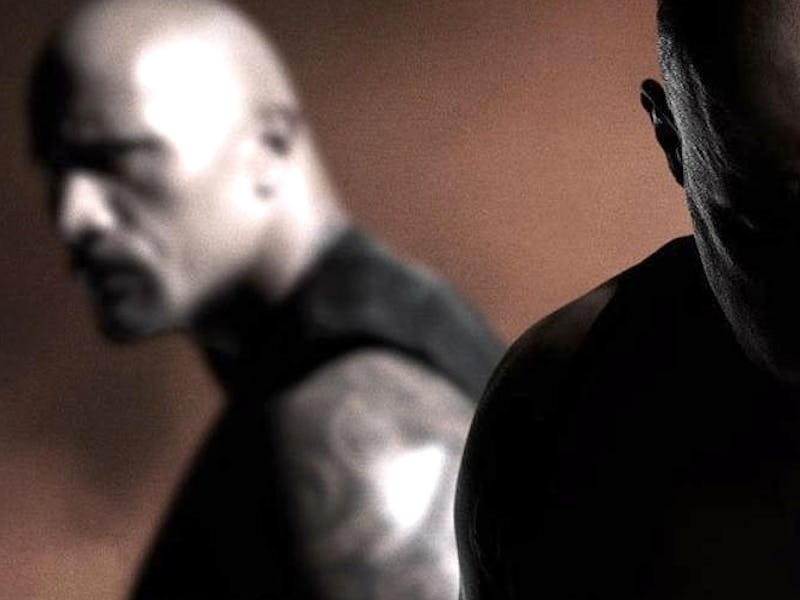No Dumb Blockbuster: ‘Fast and the Furious’ Is a Greek Tragedy
The relentless franchise has more in common with Aeschylus and Homer than you realize.

The only thing more unrelenting than Vin Diesel and The Rock in the Fast and the Furious movies is the popularity of the franchise: The latest installment, Fate of the Furious, has grossed over $900 million dollars globally in just a few weeks. And while the hot action and endless use of the word “family” may be the obvious attractions, the larger appeal of these films might be connected to their similarity to classic Western myths.
Joseph Howley, an Assistant Professor of Latin and Classical Studies at Columbia University, watched Fate of the Furious for Inverse and came away with some obvious parallels. According to Howley, The Rock is basically the Trojan badass Ajax, Vin Diesel is the Homeric hero Odysseus, and the entire franchise’s theme of “family” is a retread of a Roman desire to create a dynasty.
“In the epic stories, it’s very simple to see how people are excellent,” Howley tells Inverse. “You just put them in front of a really bad guy, and then they beat the bad guy, and that’s how they’re excellent. In Fate of the Furious, Vin Diesel succeeds in part because he’s clever and resourceful and strong, sort of like Odysseus.”
And so part of what makes the heroes of the Furious franchise so appealing and durable is the same thing that makes the heroes of Greek and Roman myth appealing, too. Howley asserts that the Furious films succeed because since the time of Greek myths, audiences have enjoyed seeing familiar characters in new settings. Specifically, when an epic character has a “transition to tragedy” it can recontextualize a familiar hero in a new setting. And so, Howley compares Fate of the Furious to Aeschylus’s Oresteia.
Even though Oresteia was written hundreds of years after the character Agamemnon first appeared in The Ilaid, he pops up again, only this time in a more tragic story. “We all know Agamemnon from The Iliad, and then all through The Odyssey, you’re kind of hearing murmurs that something really bad happened to Agamemnon when he got home. Then you read Aeschylus’s Oresteia, and there’s the bad thing happening to him, but it’s like a new mode and a new situation,” Howley explains. “I think that’s what happens in Fate of the Furious: The important thing is here’s the characters again, and they’re in a slightly new situation, but you’ll recognize them.”
And the situation, it turns out, isn’t even all that important.
“I couldn’t even tell you what happened in Fast 7, and I’m not even sure I could really reconstruct the plot of Fate of the Furious,” he says. “But that’s not the point. The idea is having the characters stay fixed and rotating the setting of the situation around them. That seems to be very reminiscent of the long experience of myth.”
Not all the characters in the Furious films are exactly like the characters of antiquity, but Howley thinks some of them are pretty damn close. “The Rock is obviously Ajax from The Iliad. Ajax is the guy who’s just really big, and really strong, and he can fight anyone and win. And there’s The Rock, just kind of more enormous and more powerful than anyone else.” But the Rock apparently can be Agamemnon too, and Vin Diesel can be Achilles. “You meet Agamemnon in The Iliad, and there he is on the battlefield of Troy, and he’s being kind of a jerk to Achilles, and there’s this sort of conflict over pride and power. Then you start reading The Oresteia, and now he’s come home. That really struck me in terms of the way we first see The Rock in The Fate of the Furious at his daughter’s soccer game.”
But it’s not just the characters and their movement from one adventure to the next that ties the Furious films to the ancient classics. Even the basic imagery of any given Fast and the Furious installment is a direct evolution of Hellenic machismo. “These movies are based on the premise that a car can just do anything. You have this sense of the car as the fundamental unit of heroism,” he says. “When you look at Greek art especially, you really see the way that the male body is this fundamental unit. The male body is the thing that fights, and the male body is the thing that kind of exerts power.”
Diesel’s Dom gives a lot of lip service to the notion of family, even though many members of his “crew” are not, in fact, related to him by blood. The film’s biggest “I am Spartacus!” moment comes when all the other members of his team surround him in their cars to protect his body for a fireball. This concept of a family created for the purposes of protection and power is, perhaps, the ultimate proof that the Furious franchise is the reigning Greco-Roman myth.
“In the early Roman Imperial dynasties, emperors would basically use adoption to create the families that they needed or that they found politically should be seen,” Howley says. “There’s this idea of that you can kind of assemble around you the household and the children you need to see.”
So, when you’re watching Vin Diesel gather around his comrades — and new infant son — in the final moments of The Fate and the Furious, you might be witnessing a 21st Century blockbuster, or, the continuation of a contemporary Greco-Roman epic, already speeding past us with fury.
The Fate of the Furious is out in wide release.